Dari Bumi, Matahari terlihat bagai bola kuning yang menyilaukan. Meski menampilkan wajah beda, foto-foto sang surya yang diambil satelit luar angkasa masih dua dimensi.
Dan, pada Minggu 6 Februari 2011 terbukti: Matahari berbentuk bola. Satelit milik Badan Antariksa Amerika Serikat (NASA) berhasil mengambil gambar Matahari secara tiga dimensi.
"Ini adalah untuk pertama kalinya kita bisa melihat aktivitas manusia secara utuh dalam tiga dimensi," kata Angelos Vourlidas, ilmuwan STEREO di Laboratorium Angkatan Laut, Washington, DC, seperti dimuat situs NASA.
Ini, tambah dia, adalah peristiwa besar dalam bidang fisika Matahari. "STEREO menguak wajah asli Matahari-- bola plasma panas dengan medan magnet mirip tenunan rumit," tambah dia.
NASA mengirimkan dua satelit Solar Terrestrial Relations Observatory (STEREO) ke dua posisi Matahari secara berlawanan. Masing-masing mengambil foto Matahari 180 derajat. Dua gambar itu lalu digabungkan menjadi satu, membentuk bola merah membara.
 |
| Gambar Matahari yang diambil STEREO (NASA) |
Untuk merilisnya ke publik, NASA memilih waktu yang bertepatan dengan momentum laga Superbowl saat Greenbay Packers melawan Steelers.
Dengan melihat gambaran utuh Matahari diharapkan akan berperan dalam pemantauan cuaca Bumi. Juga diyakini akan membantu terwujudknya impian manusia mengirimkan armada penjelajah langit ke seluruh tata surya. Untuk melihat video utuh Matahari lihat di sini
dan bisa didownload disini.
Nah, dengan demikian nih, kita bisa melihat bentuk matahari seutuhnya seperti apa dan bagaimana.
STEREO diluncurkan pada 2006, tugasnya adalah untuk melacak aliran energi dan materi Matahari ke Bumi. Satelit ini juga menyediakan gambar sistem Matahari-Bumi yang unik dan revolusioner. Misi mengambil gambar utuh Matahari secara tiga dimensi telah dilakukan sejak 2007.
Pada 2009, si kembar STEREO berhasil mengambil gambar struktur letusan di korona Matahari (coronal mass ejections) yang diyakini bisa berakibat negatif ke Bumi. Diperkirakan terjadi 2013 mendatang, peristiwa badai Matahari diperkirakan akan mengganggu komunikasi, navigasi, satelit, dan pembangkit listrik di Bumi.
STEREO dibangun dan didesain oleh para ilmuwan dari sejumlah negara, AS, Inggris, Prancis, Jerman, Belgia, Belanda, dan Swiss.
Kepada Telegraph, ilmuwan Inggris Dr Chris Davis yang terlibat dalam proyek STEREO mengatakan hasil kerja dua satelit itu sangat memuaskan. "Saya sangat gembira langkah maju ini, saya membayangkan di masa depan, observasi Matahari akan makin unik."
Sementara, pada The Guardian, ilmuwan Laboratorium Rutherford Appleton, Oxfordshire, Richard Harrison mengatakan hasil gambar STEREO akan mengubah persepsi orang terhadap Matahari.
"Matahari bukan lingkaran kuning seperti banyak orang kira," kata dia. "Ini sangat kompleks, dengan gambaran tiga dimensi, esensi untuk cara kerjanya," kata dia. (Daily Mail)
Source: vivanews
Foto-foto dan video lain yang saya copas dari STEREO Sun360:
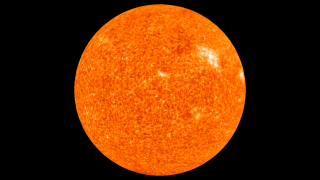 | STEREO Reveals the Entire Sun.Short narrated video about STEREO and its historic 360 degree view. For complete transcript, click here. Available formats: 1280x720 (59.94 fps) QT 2 GB 1280x720 (59.94 fps) QT 1 GB 1280x720 (29.97 fps) QT 493 MB 1280x720 (29.97 fps) MPEG-4 113 MB 960x720 (29.97 fps) MPEG-4 108 MB 1280x720 (30 fps) QT 81 MB 1280x720 (59.94 fps) QT 37 MB 640x360 (29.97 fps) MPEG-4 30 MB 320x180 (29.97 fps) MPEG-4 12 MB 1280x720 GIF 273 KB 320x180 PNG 116 KB How to play the movies | |
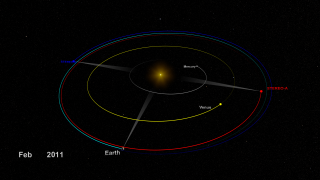 | The STEREO mission consists of two spacecraft orbiting the Sun, one moving a bit faster than Earth and the other a little slower. In the time since the STEREO spacecraft entered these orbits near the beginning of 2007 they have been slowly separating. In Feb. 2011 they reach the point at which they are on opposite sides of the Sun and can observe the entire far side of the Sun. Available formats: 1280x720 (59.94 fps) QT 999 MB 1280x720 (29.97 fps) QT 196 MB 1280x720 (29.97 fps) MPEG-4 59 MB 1280x720 (30 fps) QT 36 MB 960x720 (29.97 fps) MPEG-4 33 MB 1280x720 (59.94 fps) QT 17 MB 640x360 (29.97 fps) MPEG-4 10 MB 320x180 (29.97 fps) MPEG-4 4 MB 1920x1080 TIFF 1 MB 320x180 PNG 209 KB How to play the movies | |
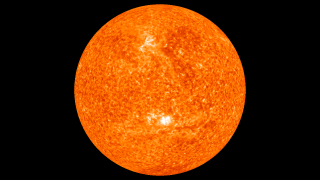 | Rotating solar sphere made from a combination of imagery from the two STEREO spacecraft, together with simultaneous data from the Solar Dynamic Observatory.This movie is made from data taken on January 31, 2011. STEREO is able to take images like this once every ten minutes. Because the STEREO separation was still slightly less than 180 degrees at that time, the small gap on the far side of the Sun has been interpolated over to simulate the full 360 degree view that STEREO will see. This gap will start to disappear on February 6, 2011, and will completely disappear over the next several days. The regions near the seam between the STEREO Ahead and Behind images appear stretched out because they are at the edges of the Sun in the original images. As the STEREO spacecraft continue to move further around to the farside of the sun, imaging in this part of the globe will improve. Credit: NASA/Goddard Space Flight Center/STEREO/SECCHI Available formats: 1280x720 (59.94 fps) QT 414 MB 1280x720 (60 fps) Frames (Full Sun 1 31 11) 1280x720 (29.97 fps) QT 15 MB 1280x720 (30 fps) QT 15 MB 960x720 (29.97 fps) MPEG-4 14 MB 1280x720 (59.94 fps) QT 7 MB 1280x720 (29.97 fps) MPEG-4 6 MB 640x360 (29.97 fps) MPEG-4 4 MB 320x180 (29.97 fps) MPEG-4 1 MB 1280x720 GIF 282 KB 320x180 PNG 118 KB 160x80 PNG 31 KB 80x40 PNG 8 KB How to play the movies | |
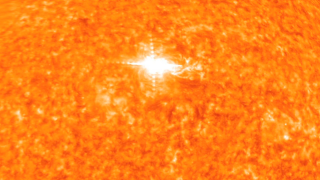 | Zoom in to solar activity visible on the far side of the Sun from the STEREO Behind spacecraft on January 13, 2011. The images show a young, fast-growing magnetic active region of the solar atmosphere which produces solar flares and ejections of material from the sun. These images were taken by STEREO's Extreme UltraViolet Imager (EUVI). The brightest, most active areas show material at temperatures as-high-as 1.8 million degrees C, while the quieter parts of the images show material at temperatures of only 80,000 deg C. This activity occurred on the far side of the sun and so could not be directly seen from Earth. The STEREO separation was still less than 180 degrees at that time, and the small gap on the far side of the Sun which would be briefly visible in the film has been interpolated over to simulate the full 360 degree view that STEREO will see.Credit: NASA/Goddard Space Flight Center/STEREO/SECCHI Available formats: 1280x720 (59.94 fps) QT 411 MB 1280x720 (29.97 fps) QT 32 MB 1280x720 (30 fps) QT 16 MB 960x720 (29.97 fps) MPEG-4 15 MB 1280x720 (29.97 fps) MPEG-4 8 MB 1280x720 (59.94 fps) QT 7 MB 640x360 (29.97 fps) MPEG-4 4 MB 320x180 (29.97 fps) MPEG-4 1 MB 1280x720 TIFF 2 MB 320x180 PNG 257 KB How to play the movies | |
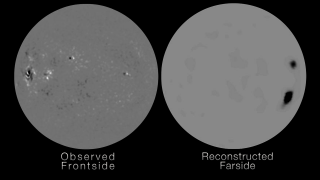 | Active regions rotating from the observed front side of the Sun to the helioseismic reconstructed far-side and back again to the front side in October/November 2003. Large active regions were clearly visible in the helioseismic images. These particular ones were extremely active and produced the well known Halloween solar storms. Credit: NASA/Goddard Space Flight Center/MDI/GONG(NSO/NSF)/HMI Available formats: 1280x720 (59.94 fps) QT 144 MB 1280x720 (30 fps) QT 5 MB 1280x720 (59.94 fps) QT 4 MB 960x720 (29.97 fps) MPEG-4 3 MB 1280x720 (29.97 fps) QT 2 MB 640x360 (29.97 fps) MPEG-4 1 MB 1280x720 (29.97 fps) MPEG-4 1 MB 320x180 (29.97 fps) MPEG-4 515 KB 1280x720 PNG 240 KB 320x180 PNG 75 KB How to play the movies | |
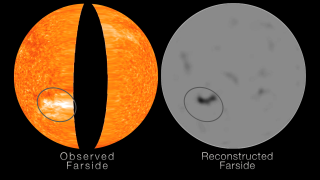 | Farside direct observations from STEREO (left) and simultaneous helioseismic reconstructions (right). Medium to large size active regions clearly appear on the helioseismic images, however the smaller ones fall within the noise level. STEREO observations of the far-side will help calibrate and further improve the helioseismic technique.Credit: NASA/Goddard Space Flight Center/SECCHI/GONG(NSO/NSF)/HMI Available formats: 1280x720 (59.94 fps) QT 409 MB 1280x720 (30 fps) QT 14 MB 960x720 (29.97 fps) MPEG-4 13 MB 1280x720 (29.97 fps) QT 10 MB 1280x720 (59.94 fps) QT 6 MB 1280x720 (29.97 fps) MPEG-4 5 MB 640x360 (29.97 fps) MPEG-4 4 MB 320x180 (29.97 fps) MPEG-4 1 MB 1280x720 TIFF 787 KB 320x180 PNG 105 KB How to play the movies | |
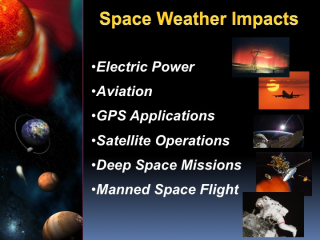 | The need for space weather services has grown significantly in past years as the technology we rely on for everyday life has become increasingly vulnerable to space weather. America's vulnerability to space weather is rising fast as our national and global critical technology infrastructure becomes more complex and dependent on advance technology. These recent advances in our technological infrastructure drive emerging space weather service needs undreamed of just a decade ago. Our advanced technological infrastructure will face challenges from the increase in solar activity and are being addressed at the highest levels of government.Credit: NOAA Space Weather Prediction Center Available formats: 720 x 540 JPEG 98 KB 320 x 240 PNG 273 KB | |
 | The critical observations from STEREO and SDO will help provide accurate and timely space weather storm warnings, and will aid greatly in our efforts to protect the technologies we have become so dependent in our daily activities. Measurements of coronal mass ejections from the STEREO spacecraft provide vital input for NOAA’s space weather forecasters. Enlil is the first operational physics-based numerical space weather prediction model. Using STEREO input, the model computes the trajectory of solar storms between Sun and Earth, and provides forecasts of geomagnetic storms out to 96 hours. Credit:WSA-Enlil Model: NOAA in partnership with AFW, AFRL (Nick Arge, WSAdeveloper), George Mason University (Dusan Odstrcil, Enlil modeldeveloper), NASA, NSF, and NRL. Available formats: 1280x720 (59.94 fps) QT 294 MB 960x720 (29.97 fps) MPEG-4 10 MB 1280x720 (30 fps) QT 10 MB 1280x720 (29.97 fps) QT 7 MB 1280x720 (29.97 fps) MPEG-4 5 MB 1280x720 (59.94 fps) QT 4 MB 640x360 (29.97 fps) MPEG-4 3 MB 320x180 (29.97 fps) MPEG-4 1 MB 1280x720 TIFF 1 MB 320x180 PNG 136 KB How to play the movies | |
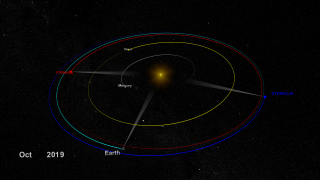 | The continuing orbits of the two STEREO spacecraft as they orbit on the far side of the Sun until 2019. Available formats: 1280x720 (59.94 fps) QT 913 MB 1280x720 (29.97 fps) QT 282 MB 1280x720 (29.97 fps) MPEG-4 52 MB 1280x720 (30 fps) QT 32 MB 960x720 (29.97 fps) MPEG-4 31 MB 1280x720 (59.94 fps) QT 14 MB 640x360 (29.97 fps) MPEG-4 9 MB 320x180 (29.97 fps) MPEG-4 3 MB 1920x1080 TIFF 2 MB 320x180 PNG 281 KB How to play the movies | |
 | View of the sun in ultraviolet primarily from STEREO B showing an active region not visible from Earth. Available formats: 2048 x 2048 JPEG 378 KB 320 x 320 PNG 394 KB | |
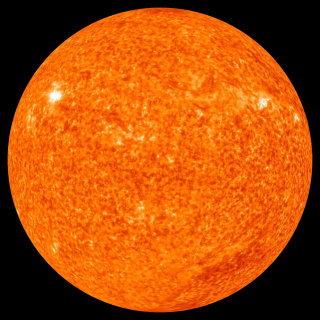 | View of the sun in 304 Angstrom ultraviolet from STEREO. Available formats: 2048 x 2048 JPEG 449 KB 320 x 320 PNG 399 KB | |
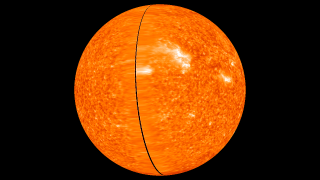 | Rotating solar sphere using 304 Angstrom Ultraviolet light. This image is from February 6, 2011 and does not use any interpolation so there is a slight gap in coverage. Available formats: 1280x720 (59.94 fps) QT 207 MB 1280x720 (60 fps) Frames (Full Sun 2 6 11) 1280x720 (59.94 fps) QT 90 MB 1280x720 (29.97 fps) QT 10 MB 960x720 (29.97 fps) MPEG-4 7 MB 1280x720 (29.97 fps) MPEG-4 3 MB 1280x720 (30 fps) QT 7 MB 1280x720 (59.94 fps) QT 3 MB 640x360 (29.97 fps) MPEG-4 2 MB 320x180 (29.97 fps) MPEG-4 902 KB 1280x720 GIF 247 KB 320x180 PNG 110 KB How to play the movies |


No comments:
Post a Comment